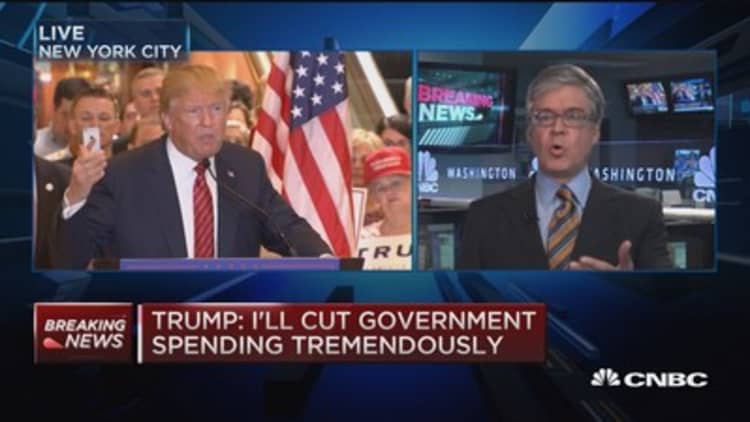In an effort to transform himself into a billionaire populist, Donald Trump has presented a tax plan designed to appeal to conservatives and voters who are angry with the rich.
But while he's selling it as a boon for the middle class, the biggest gains would likely flow to the wealthy.
The plan's main selling point for individuals making less than $25,000 and couples making less than $50,000. While nearly half of Americans already pay no income taxes, Trump said the change would eliminate taxes for an additional 31 million Americans.
Read More
At the same time, he said the plan would take away deductions and "loopholes" that are mainly exploited by the wealthy. That includes eliminating the so-called "carried interest" loophole used by hedge-funders and private equity chiefs.
"There will be people in the very upper echelons that won't be thrilled with this because we're taking away their deductions," Trump said.
He added that unlike some of his other opponents, specifically mentioning Hillary Clintion and Jeb Bush, he doesn't receive campaign money from rich donors who have sought to preserve their deductions.
Yet a close look at his proposal — which still lacks many basic details — suggests that similar to the Bush plan, the majority of the benefits would flow to the wealthy. In some ways, it could be even more generous.

The biggest benefit for the top 1 percent would be the proposed reduction of the highest income-tax rate, which Trump said he would cut from 39.6 percent to 25 percent. Bush's proposal is 28 percent.
And like Bush, Trump would also cut the tax rate for long-term capital gains — which flow mainly to the wealthy — to 20 percent, from the current 23.8 percent.
Both Trump and Bush have also said they would overhaul deductions except for charity. Trump said he would eliminate deductions and "loopholes" except for charity, and Bush said he would cap deductions at 2 percent of adjusted gross income.
Both plans would also eliminate the alternative minimum tax and the estate tax, which Trump calls "double taxation." He said the latter tax forces many families "to go through hell," even though the current exemption is $5.43 million for individuals and nearly $11 million for couples. Therefore, it only applies to the wealthiest 0.12 percent of estates.
It's too early to know exactly how much money Trump's plan would save millionaires or billionaires like himself. When asked whether his own taxes would fall under the plan, he said "everyone will do better" — including the wealthy — because it would improve growth.
But an analysis released earlier this month by the independent Tax Foundation found that the top 1 percent of earners would reap the largest financial benefits from Bush's plan.
While the middle 40 to 50 percent of taxpayers would see their after-tax incomes grow by 12.5 percent under that plan, the top 1 percent would see their incomes grow by 16.4 percent — the highest of any group, according to the Tax Foundation.
Since Trump's plan calls for an even lower top tax rate on the wealthy, it could even better for those at the top.
Correction: An earlier version misstated Bush's proposal for deductions.




